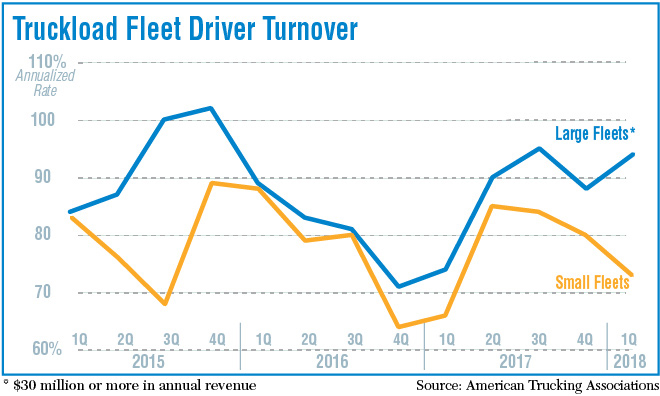
A major concern that most trucking company executives face is retaining their current staff. This concern is highlighted by the significant difficulty of finding new drivers. As an executive, it is your responsibility to create a safe and reliable work space and to allocate your time to invest in your drivers, your equipment, and your team’s well being. Not prioritizing these crucial elements to your company culture will lead to higher driver turnover and future recruiting costs.

According to data from the ATA – in Q3 of 2020, the annualized turnover rate at truckload carriers with more than $30 million in annual revenue rose 10 percentage points to 92% in the third quarter of 2020. The rate at smaller truckload carriers rose 14 points to 74%.. Despite the trucking industry having such a high turnover rate, there are best practices to implement in your company that will help with driver retention.
1. Get Feedback From Your Drivers
You can’t improve what you don’t measure. If you’re not tracking employee engagement in the first place, how can you possibly expect to make it better? A detailed surveying strategy that gives you a perspective on your drivers’ overall opinion of your company will give you the insight needed in a timely fashion.
Regularly surveying your drivers is the easiest way to improve engagement and you’ll identify from the source what changes need to be implemented to make work more enjoyable for everyone.
When developing a survey, ensure that your drivers understand why you are asking for their input, where the surveys are coming from, and how they will be distributed. Acting on your fleet members’ feedback is also crucial, so you should commit to building their feedback into your planning and consideration process.
Implementing changes based on employee feedback will result in a more productive workforce, which means happier drivers and happier clients.
2. Act on the Feedback and Make Those Promises
Now that you are receiving feedback from your drivers, the next step is to act on the responses.
In order for your driver retention to increase, changes will need to be implemented. In addition to improving the overall work environment, it also shows the drivers that you as the company care about them.
With feedback coming from your drivers, you want to make sure you review the responses efficiently. Reviewing and making considerations based on the feedback can be time consuming and you don’t want it to entirely interfere from other items in your agenda. Create a process for reviewing and considering driver feedback into your management, planning, metrics, and compensation systems.
When implementing new policies for your company, make sure to widely communicate them to your drivers. Share how you’re applying their feedback as well as the impact of changes they inspired. This strategy will show your whole entire fleet that their voice is heard and encourage them to continually give feedback.
For implementing new policies and changes, consider creating a committee that discusses and prioritizes driver input, especially for larger fleets.
3. Increase Driver Wages
One of the best ways to keep a driver is to pay them the right amount. According to the American Trucking Association, one of the main reasons there was a major decrease in driver turnover in the fourth quarter of 2017 is that driver pay increased.
Since the 1970s, the amount that fleet drivers earn has gone down by about 50% when adjusting for inflation.
The National Transportation Institute (NTI) created a study showcasing how drivers’ wages in today’s society don’t correlate to what they should be paid based on the dollar value as well as inflation variables from the 1970s.They say that a driver in 2016 who earned $52,406 would have earned around $101,600 as a unionized driver in 1979 for the same amount of work.

4. Incentive Programs
For drivers, especially those with long routes, their efforts can sometimes go unnoticed by managers who can’t interact with them on a daily basis.
Being a driver is very demanding and they must follow strict protocols while performing a job that is physically and mentally draining.
As a fleet manager you want to keep your drivers motivated and one way to do that is by creating an incentive/rewards program. For example, there could be a rewards system based on the amount of “safe driving miles” that a driver has done. Your drivers will notice that you appreciate their effort and it will motivate them to perform better.
The reward doesn’t necessarily need to be a pay raise or a bonus. It could be something as simple as a gift card to their favorite coffee shop or retailer, or even providing company paraphernalia. Even having a “driver of the month” or “driver of the year” program to recognize your top performers helps with driver retention and overall morale.
Every little bit of incentive you provide to your drivers can make a huge impact when it comes to how drivers feel about the overall work environment.
5. Time at Home Opportunities
Being a driver requires long hours on the road and takes the drivers time away from their families, especially for those who are married with children. Work-life balance is something that most employees would like to achieve. In fact, in a recent survey of CDL School graduates, 42% of respondents listed home time as the most important factor when deciding on a company to work for. It’s important to take that into consideration when it comes to increasing your driver retention rate.
Even in a demanding career like truck driving, employers can help their teams enjoy family time and life outside of work. The key is to build visibility into driver calendars. The further in advance truckers know their schedules, the more they can plan around it. If they know when they’ll be home next, they can plan for family time.
6. Prioritize Your Drivers’ Health
Dedicating your time and resources to ensure the safety and wellness of your drivers will go a long way to increasing your driver retention. According to Science Direct’s survey, 70% of long haul truck drivers perceived their delivery schedules as unrealistically tight.
This puts a lot of pressure on drivers to meet those deadlines.
Even with regulations at the federal level in place to regulate the trucking industry, the health and safety of drivers is still a concern considering driving up to 14 consecutive hours is still permitted.
Fatigue, sleep apnea, loneliness, and depression are all common side effects in this line of work, and shouldn’t be glossed over.
To help counteract the high levels of stress to their drivers, fleets are now offering different health benefits, including on-site gyms, free health screenings and nutrition programs.
In addition to these amenities, it’s important to be competitive when it comes to health insurance and to get a better understanding of what your competitors are doing.
7. Communication, Communication, Communication
An open line of communication helps managers develop a rapport with their drivers in addition to helping the drivers feel more engaged/invested in the organization.
If drivers feel like valued members of the team whose ideas are heard and respected, they will be more likely to go above and beyond their job description.
This is a simple addition that can help drivers feel like true partners. It’s not always enough to just say your managers are available to talk.
For some personalities, it’s best to be proactive by setting up semi-annual reviews, employee newsletters, and weekly calls/meetings just to check in.
This increases opportunities to discuss small issues before they blow out of proportion and helps to close expectation gaps. It’s also a good way to collect feedback and offer guidance to help employees meet goals.
8. Implement New Technologies For Your Drivers
Invest in technology that makes drivers’ daily routines easier, safer, and more productive.
Smarter routing and scheduling can bring drivers home sooner with more efficient trips, too. Drivers who get home more often are more satisfied, so using a fleet tracking system that blends GPS and mapping data can help in driver retention.
Utilizing new technologies to help with driver safety can help as well. For example, devices like front-facing dashcams and electronic logging devices can help you see things from the drivers’ perspective when there’s an accident.
This will help protect your drivers from any false claims when they aren’t at fault.
An experienced driver can become an asset to any transportation organization. However, when a new driver has to be recruited, it is a significantly riskier decision. Apart from financial constraints, time, patience, and energy have to be invested in a new driver’s development.
This industry is nothing without its drivers. Hence, fleet managers should create strategies and policies that will help them in retaining valuable employees.
The Bottom Line
Driver shortage and retention are growing problems in the trucking industry. Fleet managers should play crucial roles in ensuring that the driver retention rate in their fleets is not affecting efficiency and profitability. If you would like more tips on how to increase your driver retention, contact Transforce Group today! We have over 30 years experience and our team of professionals are ready to help!
